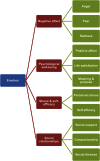Emotion assessment using the NIH Toolbox
- PMID: 23479549
- PMCID: PMC3662334
- DOI: 10.1212/WNL.0b013e3182872e11
Emotion assessment using the NIH Toolbox
Abstract
One of the goals of the NIH Toolbox for Assessment of Neurological and Behavioral Function was to identify or develop brief measures of emotion for use in prospective epidemiologic and clinical research. Emotional health has significant links to physical health and exerts a powerful effect on perceptions of life quality. Based on an extensive literature review and expert input, the Emotion team identified 4 central subdomains: Negative Affect, Psychological Well-Being, Stress and Self-Efficacy, and Social Relationships. A subsequent psychometric review identified several existing self-report and proxy measures of these subdomains with measurement characteristics that met the NIH Toolbox criteria. In cases where adequate measures did not exist, robust item banks were developed to assess concepts of interest. A population-weighted sample was recruited by an online survey panel to provide initial item calibration and measure validation data. Participants aged 8 to 85 years completed self-report measures whereas parents/guardians responded for children aged 3 to 12 years. Data were analyzed using a combination of classic test theory and item response theory methods, yielding efficient measures of emotional health concepts. An overview of the development of the NIH Toolbox Emotion battery is presented along with preliminary results. Norming activities led to further refinement of the battery, thus enhancing the robustness of emotional health measurement for researchers using the NIH Toolbox.
Figures
References
-
- Watson D, Tellegen A. Toward a consensual structure of mood. Psychol Bull 1985;98:219–235 - PubMed
-
- Anastasi A, Urbina S. Psychological Testing. Upper Saddle River, NJ: Prentice Hall; 1997
-
- Lord FM. Applications of Item Response Theory to Practical Testing Problems. Hillsdale, NJ: Lawrence Erlbaum; 1980
-
- Richardson M. The relation between the difficulty and the differential validity of a test. Psychometrika 1936;1:33–49
-
- Streiner DL, Norman GR. Health Measurement Scales: A Practical Guide to Their Development and Use. New York: Oxford University Press; 1995
Publication types
MeSH terms
Grants and funding
- 5K07CA158008-01A1/CA/NCI NIH HHS/United States
- MH066302/MH/NIMH NIH HHS/United States
- UL1 TR000150/TR/NCATS NIH HHS/United States
- HD067440/HD/NICHD NIH HHS/United States
- R01AG019181/AG/NIA NIH HHS/United States
- DK062467-10/DK/NIDDK NIH HHS/United States
- DK091786/DK/NIDDK NIH HHS/United States
- U01 AR052177-05/AR/NIAMS NIH HHS/United States
- HHSN265200423601C/NS/NINDS NIH HHS/United States
- KL2RR0254740/RR/NCRR NIH HHS/United States
- UF20303/U01AG022376/AG/NIA NIH HHS/United States
- 5R01AG026096-05/AG/NIA NIH HHS/United States
- AR52155/AR/NIAMS NIH HHS/United States
- AG012546/AG/NIA NIH HHS/United States
- R01AG031222/AG/NIA NIH HHS/United States
- MH086637/MH/NIMH NIH HHS/United States
- AR052186/AR/NIAMS NIH HHS/United States
- R01AG029884/AG/NIA NIH HHS/United States
- AR052155/AR/NIAMS NIH HHS/United States
- U01 DK082342/DK/NIDDK NIH HHS/United States
- MH056888/MH/NIMH NIH HHS/United States
- R01AG009956/AG/NIA NIH HHS/United States
- HL076852/HL/NHLBI NIH HHS/United States
- K07 CA158008/CA/NCI NIH HHS/United States
- R24MH080827/MH/NIMH NIH HHS/United States
- MH085874/MH/NIMH NIH HHS/United States
- MH083647/MH/NIMH NIH HHS/United States
- DK062467-08S1/DK/NIDDK NIH HHS/United States
- AT006453/AT/NCCIH NIH HHS/United States
- MH37896/MH/NIMH NIH HHS/United States
LinkOut - more resources
Full Text Sources
Other Literature Sources
Medical
Miscellaneous

